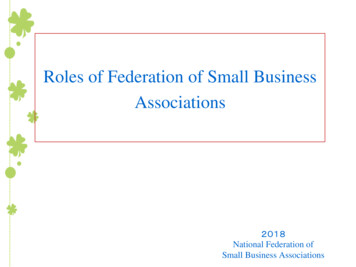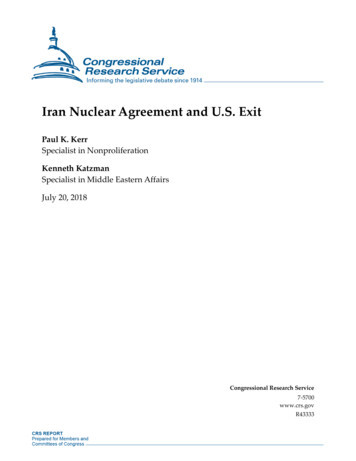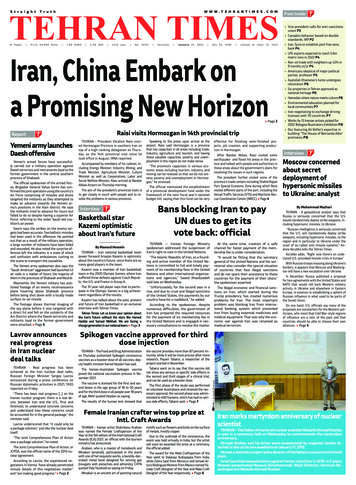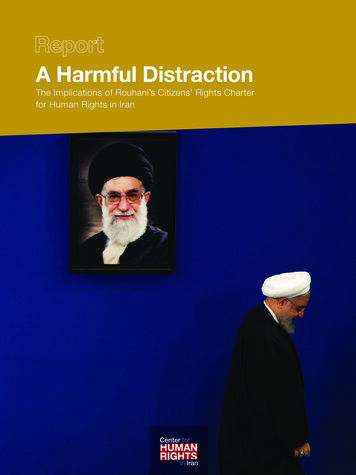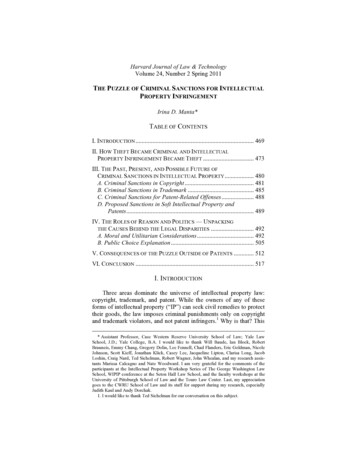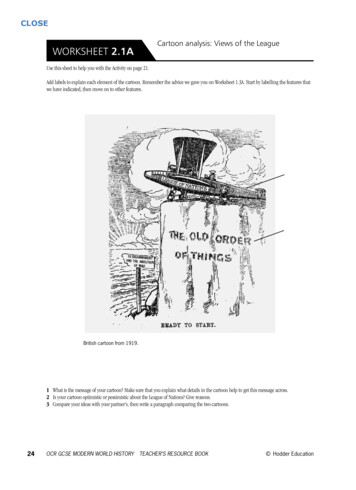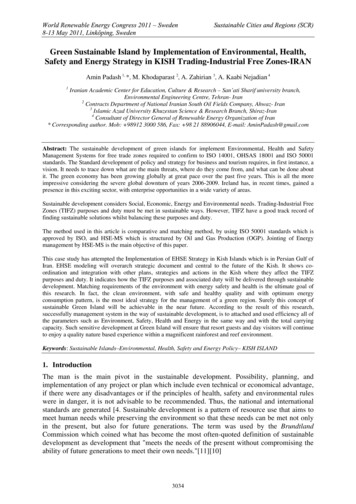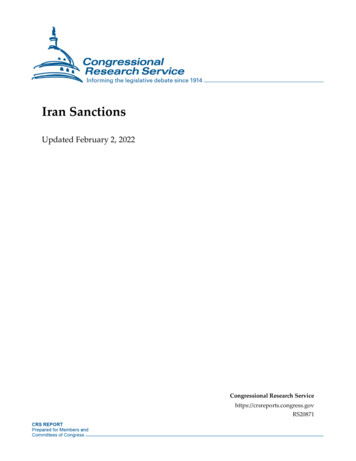
Transcription
Iran SanctionsUpdated February 2, 2022Congressional Research Servicehttps://crsreports.congress.govRS20871
SUMMARYIran SanctionsSince the 1979 Islamic revolution in Iran, the United States has imposed economic sanctions totry to change Iran’s behavior. U.S. sanctions—primarily “secondary sanctions” on firms thatconduct certain transactions with Iran—have adversely affected Iran’s economy but havearguably not, to date, altered Iran’s core strategic objectives of extending influence throughoutthe region and developing a large arsenal of ballistic missiles and armed drones.RS20871February 2, 2022Kenneth KatzmanSpecialist in MiddleEastern AffairsMany experts credit sanctions with contributing to Iran’s decision to enter into a 2015 agreementthat put limits on its nuclear program—the Joint Comprehensive Plan of Action (JCPOA).During 2011-2015, U.S. secondary sanctions contributed to the shrinking of Iran’s economy as its crude oil exports fell bymore than 50% and it could not access its foreign exchange assets held abroad. Upon International Atomic Energy Agencyverification that Iran had implemented its JCPOA nuclear commitments, the Obama Administration eased the relevant U.S.economic sanctions, and U.N. and European Union sanctions were lifted as well. The JCPOA did not require the lifting ofU.S. sanctions on direct U.S.-Iran trade or those sanctions levied for Iran’s support for regional armed factions, its humanrights abuses, and its efforts to acquire missile and advanced conventional weapons technology. Those sanctions remained inplace. U.N. Security Council Resolution 2231, which endorsed the JCPOA, kept in place, for defined periods of time, a banon Iran’s importation and exportation of arms (until October 18, 2020) and a nonbinding restriction on Iran’s development ofnuclear-capable ballistic missiles (until October 18, 2023). The sanctions relief enabled Iran’s economy to return to growthand allowed Iran to order some new passenger aircraft.On May 8, 2018, President Trump ended U.S. participation in the JCPOA and reimposed all U.S. sanctions. The reimposedsanctions, and additional sanctions imposed subsequently, were at the core of Trump Administration policy to apply“maximum pressure” on Iran, with the stated purpose of compelling Iran to negotiate a revised JCPOA that takes into accountU.S. concerns beyond Iran’s nuclear program. The policy caused Iran’s economy to fall into recession as its sales of oildeclined and Iran was again largely cut off from the international financial system. The Trump Administration alsosanctioned several senior Iranian officials as well as figures in regional pro-Iranian factions and militias. For its part, Irancontinued to develop its missile capabilities and to provide arms and support to a broad array of armed factions operatingthroughout the region, while refusing to begin talks with the United States on a more expansive, revised JCPOA. As of mid2019, Iran began exceeding many of the JCPOA limits on its nuclear program, and in so doing shortening the time expertsestimate it would take Iran to acquire enough fissile material for a nuclear weapon. The European Union and other countrieshave sought, unsuccessfully, to keep the economic benefits of the JCPOA flowing to Iran in order to persuade Iran to remainin the nuclear accord. Since mid-2019, Iran has responded to the increasing sanctions by decreasing its compliance with thenuclear commitments of the JCPOA and by conducting provocations in the Persian Gulf and in Iraq.Since taking office, President Joseph Biden has sought to implement a stated intent to rejoin the JCPOA, includingundertaking talks with Iran and the other JCPOA parties in Vienna, Austria. Those talks are ongoing as of January 2022.Administration officials have acknowledged that a U.S. return to the agreement would entail an easing of the JCPOAstipulated U.S. economic sanctions. The Biden Administration has not expanded any Iran sanctions authorities, but it hascontinued to designate Iranian and third-country-based companies that violate the U.S. sanctions laws and executive orders.See also CRS Report R43333, Iran Nuclear Agreement and U.S. Exit, by Paul K. Kerr and Kenneth Katzman; and CRSReport R43311, Iran: U.S. Economic Sanctions and the Authority to Lift Restrictions, by Dianne E. Rennack.Congressional Research Service
Iran SanctionsContentsOverview . 1Blocked Iranian Property and Assets . 1Executive Order 13599 Impounding Iran-Owned Assets. 3Sanctions for Iran’s Support for Armed Factions . 3Sanctions Triggered by Terrorism List Designation . 3Exception for U.S. Humanitarian Aid . 5Sanctions on States “Not Cooperating” Against Terrorism . 5Executive Order 13224 Sanctioning Terrorism-Supporting Entities. 5Implementation of E.O. 13224. 5Foreign Terrorist Organization (FTO) Designations . 6Other Sanctions on Iran’s Support for Regional Armed Factions . 6Executive Order 13438 on Threats to Iraq’s Stability . 6Executive Order 13572 on Repression of the Syrian People. . 7Hezbollah-Specific Financial Sanctions . 7Ban on U.S. Trade and Investment with Iran . 7What U.S.-Iran Trade Is Allowed or Prohibited? . 8Application to Foreign Subsidiaries of U.S. Firms . 10Sanctions on Iran’s Energy Sector. 10The Iran Sanctions Act . 11Key Sanctions “Triggers” Under ISA . 11Mandate and Time Frame to Investigate ISA Violations . 15Interpretations of ISA and Related Laws . 15Implementation of Energy-Related Iran Sanctions . 16Oil Export Sanctions: FY2012 NDAA Sanctioning the Central Bank . 17Implementation/SREs Issued and Ended . 18Waiver and Termination . 19Iranian Foreign Exchange Accounts “Restricted” . 19Sanctions on Arms and Weapons-Related Technology Transfers. 20Iran-Iraq Arms Nonproliferation Act and Iraq Sanctions Act . 21Banning Aid to Countries that Aid or Arm Terrorism List States: Anti-Terrorism andEffective Death Penalty Act of 1996 . 22Proliferation-Related Provision of the Iran Sanctions Act . 22Iran-North Korea-Syria Nonproliferation Act . 22Executive Order 13382 on Proliferation-Supporting Entities . 23Arms Transfer and Missile Sanctions: The Countering America’s Adversaries throughSanctions Act (CAATSA, P.L. 115-44) . 23Executive Order 13949 on Sales of Arms (September 21, 2020) . 23Foreign Aid Restrictions for Named Suppliers of Iran. 24Sanctions on “Countries of Diversion Concern”. 24Financial/Banking Sanctions . 25Targeted Financial Measures . 26Ban on Iranian Access to the U.S. Financial System/Use of Dollars . 26Punishments/Fines Implemented against Some Banks. . 26CISADA: Sanctioning Foreign Banks That Conduct Transactions with SanctionedIranian Entities . 27Congressional Research Service
Iran SanctionsImplementation . 28Waiver and Termination . 28Iran Designated a Money-Laundering Jurisdiction . 28Financial Action Task Force (FATF) . 29“SWIFT” Electronic Payments System. 29Sanctions on Iran’s Non-Oil Industries and Sectors . 30The Iran Freedom and Counter-Proliferation Act (IFCA) . 30Implementation . 31Waiver and Termination . 31Executive Order 13645/13846: Iran’s Automotive Sector, Rial Trading, and PreciousStones . 31Executive Order 13871 on Iran’s Minerals and Metals Sectors . 31Executive Order 13902 on the Construction, Mining, Manufacturing, and TextilesSector (January 10, 2020) . 32Executive Order 13608 on Sanctions Evasion . 32Sanctions on Cyber and Criminal Activities. 33Executive Order 13581 . 33Executive Order 13694 . 33U.S. State-Level Sanctions . 33Sanctions Supporting Democracy/Human Rights . 33Expanding Internet and Communications Freedoms . 34Measures to Sanction Human Rights Abuses/Promote Civil Society . 35Non-Iran Specific Human Rights Laws . 36Sanctions on Iran’s Leadership . 37Executive Order 13876 . 37U.N. Sanctions. 37Resolution 2231 and U.N. Sanctions Eased . 37Sanctions Application under Nuclear Agreements . 39Sanctions Eased by the Joint Plan of Action (JPoA) . 39Sanctions Easing under the JCPOA and U.S. Reimposition . 39U.S. Sanctions that Remained in Place under the JCPOA . 41Sanctions Imposed Subsequent to the U.S. Exit from the JCPOA . 42International Implementation and Compliance . 43European Union (EU) . 43European Special Purpose Vehicle/INSTEX . 44SWIFT Electronic Payments System . 45China and Russia . 45Japan/Korean Peninsula/Other East Asian Countries. 46Other East Asian Countries . 46India and Pakistan . 47Turkey . 47Iraq and Persian Gulf States . 48Syria and Lebanon. 49Venezuela . 49International Financial Institutions/World Bank/IMF and WTO . 49WTO Accession . 50Effectiveness of Sanctions . 50Congressional Research Service
Iran SanctionsEffect on Iran’s Nuclear Program and Strategic Capabilities . 50Effects on Iran’s Regional Influence . 51Iranian Domestic Political Effects. 52Economic Effects . 52Iran’s Economic Coping Strategies . 54Effect on Energy Sector Development . 55Human Rights-Related Effects . 56Humanitarian Effects. 56U.S. COVID Response . 56Air Safety . 57Post-JCPOA Sanctions Legislation . 57114th Congress . 57Iran Nuclear Agreement Review Act (P.L. 114-17) . 58Visa Restriction . 58Iran Sanctions Act Extension . 58Reporting Requirement on Iran Missile Launches . 58Some of the 114th Congress Legislation that was not Enacted . 59The Trump Administration and Iran Sanctions Legislation . 59The Countering America’s Adversaries through Sanctions Act of 2017 (CAATSA,P.L. 115-44). 59Major Legislation in the 115th Congress that was not Enacted . 60116th Congress . 60Other Possible U.S. and International Sanctions. 60FiguresFigure 1. Economic Indicators . 55TablesTable 1. Iran Crude Oil Sales . 20Table 2. Major Settlements/Fines Paid by Banks for Violations . 27Table 3. Summary of Provisions of U.N. Resolutions on Iran Nuclear Program (1737,1747, 1803, 1929, and 2231) . 38Table D-1. Entities Designated Under U.S. Executive Order 13382 (Proliferation) . 71Table D-2. Iran-Related Entities Sanctioned Under Executive Order 13224 (TerrorismEntities) . 76Table D-3. Determinations and Sanctions under the Iran Sanctions Act . 80Table D-4. Entities Sanctioned Under the Iran North Korea Syria Nonproliferation Act orExecutive Order 12938 for Iran-Specific Violations . 80Table D-5. Entities Designated under the Iran-Iraq Arms Non-Proliferation Act of 1992 . 82Table D-6. Entities Designated as Threats to Iraqi Stability under Executive Order 13438(July 17, 2007). 83Congressional Research Service
Iran SanctionsTable D-7. Iranians Designated Under Executive Order 13553 on Human Rights Abusers(September 29, 2010) . 83Table D-8. Iranian Entities Sanctioned Under Executive Order 13572 for Repression ofthe Syrian People (April 29, 2011) . 84Table D-9. Iranian Entities Sanctioned Under Executive Order 13606 (GHRAVITY, April23, 2012). 84Table D-10. Entities Sanctioned Under Executive Order 13608 Targeting SanctionsEvaders (May 1, 2012) . 85Table D-11. Entities Named as Iranian Government Entities Under Executive Order13599 (February 5, 2012) . 85Table D-12. Entities Sanctioned Under Executive Order 13622 for Oil and PetrochemicalPurchases from Iran (July 30, 2012) . 86Table D-13. Entities Sanctioned under the Iran Freedom and Counter-Proliferation Act(IFCA, P.L. 112-239) . 87Table D-14. Entities Designated as Human Rights Abusers under Executive Order 13628(October 9, 2012, pursuant to ITRSHRA) . 87Table D-15. Entities Designated under E.O. I3645 on Auto production, Rial Trading,Precious Stones, and Support to NITC (June 3, 2013) . 88Table D-16. Entities Designated under Executive Order 13581 on Transnational CriminalOrganizations (July 24, 2011) . 88Table D-17. Entities Designated under Executive Order 13694 on MaliciousCyber Activities (April 1, 2015) and E.O. 13848 (September 12, 2018) on Interferencein U.S Elections . 88Table D-18. Entities Designated under E.O.13846 Reimposing Sanctions (August 6,2018) . 89Table D-19. Executive Order 13871 on Metals and Minerals (May 8, 2019) . 90Table D-20. Entities Designated as Gross Human Rights Violators under Section 7031(c)of Foreign Aid Appropriations . 90Table D-21. Entities Designated under E.O. 13876 on the Supreme Leader and his Office(June 24, 2019) . 90Table D-22. Executive Order 13818 Implementing the Global Magnitsky Act (December20, 2017). 91Table D-23. Executive Order 13902 on the Construction, Textiles, and other Sectors(January 10. 2020) . 92Table D-24. Executive Order 13949 on Conventional Arms to Iran (September 21, 2020) . 92Table D-25. Entities Sanctions Under CAATSA . 92AppendixesAppendix A. U.S., U.N., EU and Allied Country Sanctions . 61Appendix B. Post-1999 Major Investments in Iran’s Energy Sector . 64Appendix C. Entities Sanctioned Under U.N. Resolutions and EU Decisions . 68Appendix D. Entities Sanctioned under U.S. Laws and Executive Orders . 71Congressional Research Service
Iran SanctionsContactsAuthor Information. 93Congressional Research Service
Iran SanctionsOverviewSanctions have been a significant component of U.S. Iran policy since Iran’s 1979 IslamicRevolution that toppled the Shah of Iran, a U.S. ally, and the late 1979 taking of U.S. diplomats inIran hostage. In the 1980s and 1990s, U.S. sanctions were intended to try to compel Iran to ceasesupporting acts of terrorism and to limit Iran’s strategic power in the Middle East more generally.After the mid-2000s, U.S. and international sanctions focused largely on trying to persuade Iranto agree to limits to its nuclear program. Still, sanctions have had multiple objectives and soughtto address multiple threats from Iran simultaneously.This report analyzes U.S. and international sanctions against Iran. CRS cannot independentlycorroborate whether any individual or other entity might be in violation of U.S. or internationalsanctions against Iran. Some of the laws and orders analyzed in this report require the blocking ofU.S.-based property of sanctioned entities. No information has been released from the executivebranch indicating the extent, if any, to which any such property is currently blocked.The sections below are grouped by function, in the chronological order in which these themeshave emerged.Blocked Iranian Property and AssetsPost-JCPOA Status: Iranian Assets Still Frozen, but Some Issues ResolvedU.S. sanctions on Iran were first imposed during the U.S.-Iran hostage crisis of 1979-1981, in theform of executive orders issued by President Jimmy Carter blocking nearly all Iranian assets heldin the United States.1U.S.-Iran Claims TribunalThe Algiers Accords that resolved the U.S.-Iran hostage crisis established a “U.S.-Iran ClaimsTribunal” at The Hague that continues to arbitrate government-to-government cases resultingfrom the 1980 break in relations and freezing of some of Iran’s assets. All of the 4,700 privateU.S. claims against Iran were resolved in the first 20 years of the Tribunal, resulting in 2.5billion in awards to U.S. nationals and firms. The major government-to-government cases involveIranian claims for compensation for hundreds of foreign military sales (FMS) cases that werehalted in concert with the rift in U.S.-Iran relations when the Shah’s government fell in 1979.On January 17, 2016 (coincident with JCPOA taking effect), the United States announced it hadsettled with Iran on additional FMS cases that were frozen when the Shah’s government fell. Iranhad been depositing its FMS payments into a DOD-managed “Iran FMS Trust Fund,” and, after1990, the Fund had a balance of about 400 million.2 Under the 2016 settlement, the UnitedStates sent Iran the 400 million balance, plus 1.3 billion in accrued interest (paid from theDepartment of the Treasury’s Judgment Fund.) In order not to violate U.S. regulations barring1The Orders included E.O. 12170 of November 14, 1979, blocking all Iranian government property in the UnitedStates, and E.O 12205 (April 7, 1980) and E.O. 12211 (April 17, 1980) banning virtually all U.S. trade with Iran. Thelatter two orders were issued just prior to the failed April 24-25, 1980, U.S. effort to rescue the U.S. Embassy hostagesheld by Iran. President Jimmy Carter also broke diplomatic relations with Iran on April 7, 1980. The trade-relatedorders (12205 and 12211) were revoked by Executive Order 12282 of January 19, 1981, following the “AlgiersAccords” (hereinafter, “Accords”) that resolved the U.S.-Iran hostage crisis.2 In 1990, 200 million was paid from the Trust Fund to Iran to settle some FMS cases. In 1991, the United States paid 278 million from the separate Treasury Department Judgment Fund to settle some additional FMS cases.Congressional Research Service1
Iran Sanctionsdirect U.S. dollar transfers to Iranian banks, the funds were remitted to Iran in foreign hardcurrency from the central banks of the Netherlands and of Switzerland. Some claims involvingthe FMS program with Iran remain under arbitration.Other Iranian Assets FrozenIranian assets in the United States remain blocked under several provisions, including ExecutiveOrder 13599 of February 2010. U.S. officials consider about 1.9 billion in Iranian Central Bank assets that wereheld in a Citibank account in New York as subject to being blocked. The accountwas in the name of Clearstream, a Luxembourg-based securities firm. In 2013,Clearstream transferred 1.67 billion to its accounts in Luxembourg. In 2019,Luxembourg courts ruled that the funds were outside U.S. jurisdiction and couldnot be transferred back to U.S.-based banks and subjected to blockage.About 50 million of Iran’s assets frozen in the United States consists of Iraniandiplomatic property and accounts, including the former Iranian embassy inWashington, DC, and 10 other properties in several states, and related accounts.3Among other frozen Iranian assets are real estate holdings of the Assa Company,a UK-chartered entity, which allegedly was maintaining the interests of Iran’sBank Melli in properties in New York City, Texas, California, Virginia, andMaryland. An Iranian entity, the Alavi Foundation, is an investor in theproperties, which the U.S. Attorney for the Southern District of New Yorkblocked in 2009. In June 2017, the United States won legal control over the NewYork office building. The Department of the Treasury report avoids valuing realestate holdings.Use of Iranian Assets to Compensate U.S. Victims of Iranian Terrorism 4Nearly 50 billion in court awards have been made to victims of Iranian terrorism. Recipientsinclude the families of the 241 U.S. soldiers
Iran Sanctions Updated February 2, 2022 Congressional Research Service https://crsreports.congress.gov RS20871
